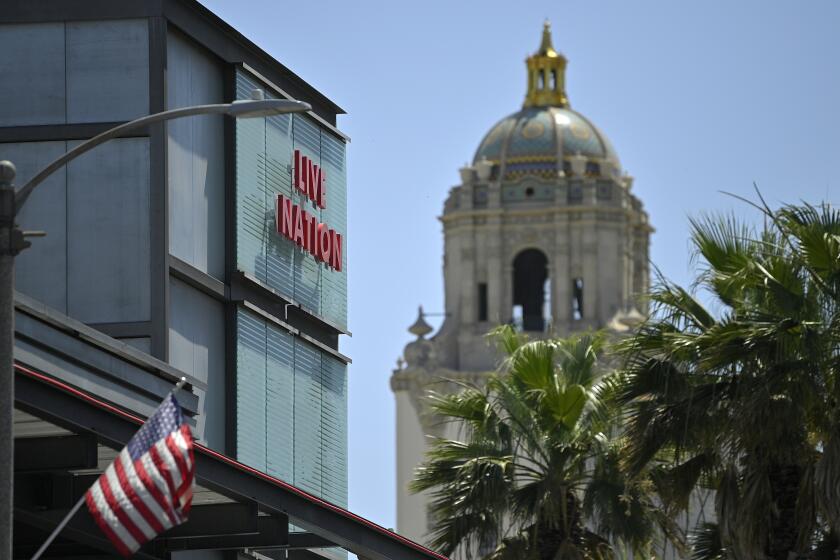Verdi was a man of, and ahead of, his time
- Share via
On Saturday, Los Angeles Opera will be giving its first performance ever of Giuseppe Verdi’s “Simon Boccanegra,” a work that straddles a longer span of time in his extraordinary evolution than any other. The story of a seafaring adventurer who fathered a child out of wedlock and is elected the Doge (ruler) of Genoa amid a feud between the Patricians and the Plebeians, “Boccanegra” was originally written in 1857 in the center of his famous middle period but then extensively revised in 1881 just before his great final period.
It is a strange yet somehow unified mix of Verdi’s middle and late styles, with traditional set pieces starting to disappear in favor of through-composed drama, with the atmosphere of the sea ever present in stretches of the music. For decades, hardly anyone staged it; the lack of hit arias and a fairly complicated plot were probably the reasons. Only in the last 40 years has it won a place in the international repertoire — and interest really picked up in 2009 when Plácido Domingo started singing the title role, hitherto reserved for baritones, in Europe, New York and now Los Angeles (three DVD recordings of Domingo as Boccanegra have been released in the past year).
“Verdi’s humanity, his dramatic genius, his melodic genius is unsurpassed in his genre,” says L.A. Opera music director James Conlon. “He transformed Italian opera into the sublime. And therefore, we need him; we need a lot more of the sublime in our lives. The first opera I saw was ‘La Traviata’; I was 11 years old, and it changed my life.”
“Verdi’s operas depict his extraordinary insight into the human condition,” Domingo adds in an email. “He cared very deeply about his protagonists, and as a result they seem very real to us. We understand the failings of his heroes, and we recognize what motivates his evil characters, too. In his operas, you get a great sense of the man himself; affectionate, sympathetic and deeply humane.”
Everyone should have a career trajectory like that of Verdi.
He started young with a couple of not-too-successful operas and then suddenly had a big early hit in his own distinct voice (“Nabucco”) at 28. Then he dug in and learned his craft with a prolific stream of historical operas — he called this period his “years in the galleys” — until he emerged with his first undisputed masterpiece (“Rigoletto”) at 37. Then, bing, bang, two more popular hit operas followed — “Il Trovatore,” “La Traviata.” He become a national hero, a symbol of freedom and Italian unification. But he didn’t rest on his laurels; he kept developing, learning, deepening, taking more and more time between pieces. He tried to retire several times to his farm, but the world wouldn’t let him — and more important, he wouldn’t let himself rest for very long.
Eventually, after “Aida” swept the world, he did quit, leaving a 16-year gap between operas, but during that time, he wrote a Requiem that has become a concert piece for special occasions, much like Beethoven’s Ninth. Finally, when he reached his 70s, in collaboration with a librettist (Arrigo Boito) who understood him perfectly, he ascended to another level of mastery with “Otello” — and in his 80th year produced a comic masterwork at last, “Falstaff.” He went out on top at the peak of his game, saw a new century in, and died in 1901 at the ripe old age of 87, well beyond the life expectancy of the time.
That’s the career of Verdi in a nutshell — but of course it wasn’t entirely a parade of triumphs, for there were struggles along the way. In quick succession before “Nabucco,” Verdi lost his family — his daughter, his son and finally his first wife — to illness. He worked so hard during his “years in the galleys,” cranking out opera after opera on demand, that he nearly lost his own health.
Moreover, Verdi was constantly battling with the political and religious censors. It came to the point where he had to completely change the setting and characters in “Un Ballo in Maschera” from a play about the assassination of the reform-minded King Gustave III of Sweden to a preposterous tale of colonial Boston (nowadays, some stage directors restore the original Swedish setting and characters). Shortly after that, he announced his first “retirement” at 46 to his friends — he probably had had enough of opera politics — and was persuaded by Count Camillo Benso di Cavour to enter real politics, serving as a deputy in a united Italy’s first Parliament. He cared — not only about his characters but also about his fellow citizens.
Even today, a Verdi opera can catch you off-guard with its relevance to our time. When “Don Carlo” was performed by L.A. Opera in 2006, some of us found that the opera’s depiction of the influence of religious fundamentalism on politics hit close to home. One can imagine that if he were alive today and living in America, Verdi’s sympathies might be with the Occupy protesters.
And what kind of works might he be writing for us? On the one hand, this is 2012, and the fragmented pop culture of our time is different from a day when something like “La donna è mobile” could become an instant hit tune that everybody knew. “Who knows — in our culture, in America — if people would have the intelligence to appreciate the work of an 80-year-old?” Conlon muses. “With our obsession about youth, what would happen?”
But Conlon believes that Verdi would come up with something that would resonate. “I think Verdi would probably write something terribly important for all of us which would probably be very different from what everybody else was writing, and [he] would not care,” he says.
“He compromised when he had to, but he never compromised willingly — and when he didn’t have to compromise anymore, you see what came out. As he was freed more and more from the necessity of pleasing anybody, you get the greatest and most perfect works at the end. And ‘Simon Boccanegra’ is on the way.”
More to Read
The biggest entertainment stories
Get our big stories about Hollywood, film, television, music, arts, culture and more right in your inbox as soon as they publish.
You may occasionally receive promotional content from the Los Angeles Times.










